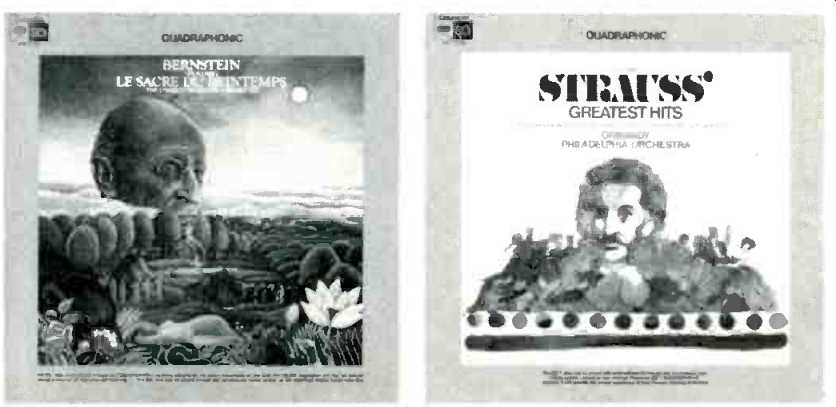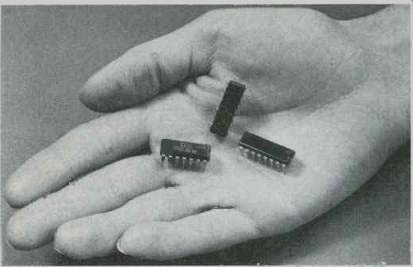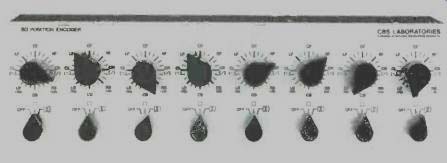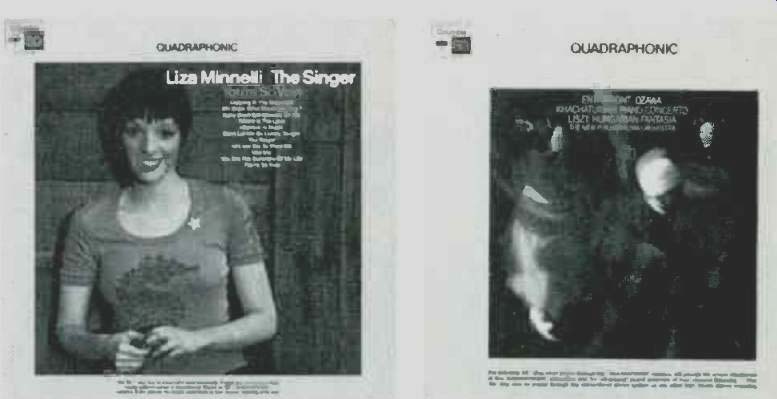By Benjamin B. Bauer* [CBS Laboratories, Stamford, Conn. 06905, USA]
To the SQ system, the past year has brought significant progress, major technological improvements, and an established public acceptance. SQ (a trademark of CBS, Inc.) effectively has become the standard matrix system worldwide.
With respect to progress, 75 brands of audio equipment produced by SQ licensees are now available or are about to become available in the USA and abroad. These 75 brands account for over 75 per cent of world's sales of audio equipment. It is estimated that over 1/2-million SQ decoders currently are in the hands of music lovers the world over.
A basic U.S. patent No. 3,708,631 has been issued to CBS covering broadly various aspects of logic decoders. A cross-license agreement has been concluded with Electro-Voice with respect to a basic Scheiber patent, No. 3,632,886 and this has enabled SQ licensees to enjoy the developments and the protection of both patents.

---Lafayette LR-4000 AM/FM receiver; Sony Model SQD 2020 "full logic" SQ
decoder
Some of the best known record labels in the USA and throughout the world have issued SQ-encoded records. More than 200 SQ albums are now commercially available.
World-renowned artists and conductors have given the SQ system an enthusiastic endorsement and have adopted it in the performance of major works. While the majority of these are of traditional "concert-hall ambience" variety, some have been especially planned for quadraphonics-such as Bernstein's Mass, Biggs at the Organ of St. George's Church, and Boulez' Interpretation of the Bartok Concerto. The greats in the worlds of jazz, rock, and country and western music have been able to create more intimate sense of identification with the listeners by applying the SQ surround-sound technique.


Stereo-FM broadcasting stations have found the SQ records to be an ideal source of quadraphonic program. SQ records are transmitted and received as conventional stereo' programs on existing FM-multiplex receivers, and are readily converted to quadraphonic reception by means of an SQ-decoder and two additional loudspeakers. A four-channel tape can be broadcast in the SQ mode by passing it through an SQ encoder and straight on to the transmitter. More than 200 FM stations are estimated currently to be transmitting SQ programs in regular program series.
The main reason for overwhelming popularity of the SQ system in broadcasting is the fact that, with respect to the stereophonic listener, full front-channel separation is preserved; and for the monophonic listener (80% of all FM receivers are still monophonic!), all four channels are reproduced at precisely equal levels. This capability of the SQ system is most important with the great new classical works as well as with the popular programs which use the surround-sound technique (with the artists distributed more or less equally in all channels). The SQ system is the only known matrix system which possesses both these desirable characteristics.
Decoding Advances
On the technical front there have been a number of major SQ advances. It should be noted that these advances have not, in any way, changed the original SQ concept which remains precisely as it was at the time of its public introduction at Montreux, Switzerland, in June of 1971.
Important improvements have been made in the area of home-type instruments, with the result that better and more economical SQ-type equipment has been produced. A solid-state integrated matrix chip (Model MC 1312) has been introduced by Motorola, under CBS sponsorship, and this has made it possible for all SQ licensees simply and inexpensively to produce precise SQ matrix decoders, both of the free-standing variety and built in to FM receivers and phonograph amplifiers.
With the recognition that the ultimate realization of SQ resides in the implementation of the logic system, a number of excellent logic decoders have been introduced in the marketplace. The simplest of these are of the front-back logic variety, which enhance the center front and back separation, allowing the naturally broad side-to-side separation of the SQ Matrix to be utilized. The more advanced ones add a "wave-matching logic" to the front-back logic circuit, allowing a 20 dB separation to be maintained all the way around the room. An even more advanced form of logic, which includes a "variable blend" together with the wave-matching logic allows the SQ decoders to maintain virtually infinite separation between the front arid the back pairs of channels for corner signals, while permitting a 20 dB channel separation to be provided in all front-back modes.

------ The SO "'full logic" decoder is comprised of these three
IC chips from Motorola.
Unique among the noteworthy full-logic decoders is a new Model SQD-2020 full-logic decoder introduced by Sony and a Model LR-4000 AM-FM receiver produced by Lafayette.
Again in cooperation with Motorola, two more SQ integrated circuit decoder modules have been designed: A full-logic module MC 1315, which embodies, in a postage-stamp size IC, a front-back logic and a wave-matching logic; and a power-transfer module MC 1314 which has the dual purpose of accepting the logic commands and translating them into enhanced quadraphonic action. The MC 1314 also acts as a gain control and loudspeaker balance element and it permits the gain of all four channels to be adjusted, with a tracking error not in excess of 1 dB over an 80 dB volume range. This action is realized with but a single potentiometer: Anyone who has attempted to obtain a well-tracking four-channel potentiometer for a master volume control of a quadraphonic system will at once recognize the advantage of such an arrangement. The balance action also is obtained with but three potentiometers: balance between the front pair of loudspeakers, the back pair of loudspeakers, and front-to-back.
A further refinement in the logic control module allows the logic action to be adjusted in order to compensate for the acoustical conditions of the listening room-a living room with carpet, drapes, overstuffed furniture usually has sufficiently good acoustics to perform well with "normal" logic action, while a room with harder boundaries and little absorption may require a super-normal amount of logic action to produce superior quadraphonic separation. The flexibility of the new IC chips permits the user readily to optimize the quadraphonic performance in his own living room, at the same time enjoying the significant savings of the IC construction.
It should be emphasized that the above developments do not detract from the' decoders already manufactured using discrete solid-state circuitry. They merely result in greater manufacturing convenience and economy. Also, it should be kept in mind that every SQ decoder, even the simplest one, in every sense of the term is a high-fidelity decoder. Its frequency characteristic, dynamic range, freedom from distortion, signal-to-noise ratio-all meet the strictest demands of high-fidelity standards. The addition of logic-even of the most sophisticated type-contributes only to precision of directional response; and so far as we have been able to ascertain most music lovers don't particularly care if, in a surround-sound situation, an instrument appears to play, say, from a northeast by east or a northeast by north direction. For the professional who does care about extreme directional precision the more advanced full-logic decoders provide complete satisfaction-but at a higher price.
Recording Advances
Significant improvements have been made in the area of professional encoding equipment. Again, these improvements have not resulted in the introduction of any incompatible changes-but to the artist, producer, and recording engineer, they have brought important new tools for creating more effective and satisfying SQ records. A new SQ encoder module Model 4211 has been designed replacing the original Model 4200 encoder. The Model 4211 module in addition to the "standard" SQ encoder mode also provides a so-called "front-looking encoding mode" especially desirable for broadcasting quadraphonic tapes not previously produced with the SQ technology in mind and a "back-looking encoding mode" for providing special effects within the SQ code requirements. The Model 4211 module also provides input terminals for improved side-mode encoding which results in enhanced separation for center-side signals.

------- CBS Laboratories' improved Model 4211 encoder module
The Model 4211 module also is capable of accepting one or more pan pot modules, Model 4212. Each pan pot module has 8 directional potentiometers which allow optimum encoding conditions to be achieved over 360° horizontal circle.
By using two pan pot modules, for example, each channel of a I6-track master machine may be connected directly to its corresponding pan pot, which allows the producer readily to place any sound in any desired location or to move it about at will. Again, by the flip of a switch, each pan pot may be caused to guide the sound in a figure-eight mode, allowing the signal to be "panned" across the front and back walls or along the diagonals, and even to achieve "diagonal splits" with the outputs appearing preferentially in the left front-right back loudspeaker pair or in the right front-left back pair.
It should be noted that the SQ system is the only matrix system which allows the diagonal pairs of splits to be achieved.

------ CBS Laboratories' Model 4212 "pan pot" position encoding
module
A third encoding module is the discrete module Model 4213. This also plugs into the 4211 encoder translating whatever pan-pot positions have been selected for the SQ-encoded tape onto four discrete outputs. With the Model 4213 module, two master tapes are produced simultaneously: An SQ-encoded two-channel tape, which at once can be used to cut an SQ record, and a discrete four-channel tape, which simultaneously can be used to produce Q-8 cartridges. Therefore, one tape generation is saved resulting in increased fidelity of the final product.
A very significant economic advantage of the new position encoder described above is that it allows any stereophonic editing console to be converted into quadraphonic console, thus saving thousands of dollars and months of time to the studio manager.
An improved professional studio decoder, Model 2400A (Screw Terminals) and 2400B (with Cannon Plugs), has been introduced by CBS Laboratories providing the recording studio with precision means of decoding the encoded program, thus verifying the results to be obtained from the encoded master tape, or the reference disc, in an optimum manner.
Public Acceptance
The test of merit of an artistic product is the acceptance accorded to it by the artistic and scientific community and its reception by the listening public.
On both scores, the SQ system has been eminently successful. Mark Kanny in FM Guide for February 1972, speaking of Bernstein's rendition of Also Sprach Zarathustra says, "... what I heard from the SQ disc is very different; the sound is rich and full-bodied and the performance carries conviction. I heard Bernstein conduct this piece in Philharmonic Hall, and frankly, Columbia's record sounds much better." Referring to the SQ issue of the Broadway-cast album "Company," Robert Long of High Fidelity magazine asserts "... there is real excitement in the album, and it reconfirms my feeling that the four-channel medium should be able to help Broadway scores escape from the patness--the canned-ness if you will--that can make the recording seem like a pale reflection of the theatre performance." Writing about the Boulez-Bartok SQ release, Martin Meyer, in a recent Esquire article, predicts: "It will ... greatly influence the future of musical composition," and Newsweek magazine refers to the recording as a "milestone." The SQ broadcast of Ormandy conducting the Philadelphia Orchestra playing Tchaikovsky's 1812 Overture, during President Nixon's Inaugural Concert this year, has attracted an immense amount of favorable comment.

The public has been responding to the SQ product with unexpected alacrity. Sales of SQ records, despite the $1.00 higher list price compared to the stereo counterparts, have been increasing steadily each month for over 2 years and currently are running, on the average, at over twice the monthly rates of last year's sales. SQ has brought about an unexpected renaissance of interest in the classical repertoire: The SQ issues of all new releases are outselling many of the corresponding stereo records by a significant factor.
An important factor in the popularity of SQ records is the recognition by the users that they can be readily played on existing stereophonic phonographs producing quality equal (or as some claim, superior!) to that currently enjoyed with the stereophonic product, without in any way impairing or endangering their quadraphonic capability which at once becomes evident when the record is played on a quadraphonic reproducer.
The age of Quadraphonics is truly here, and SQ is paving the way to its universal acceptance as a new standard of musical enjoyment in the home.
---------------------
(adapted from Audio magazine, Jul. 1973)
Also see:
Status: The CD-4 System (Jul. 1973)
The Evolution of Four-Channel Equipment (Jul. 1973)
Why You Should Buy Four-Channel Now (Jul. 1973)
Quadraphonic Headphones (Jun. 1973)
= = = =